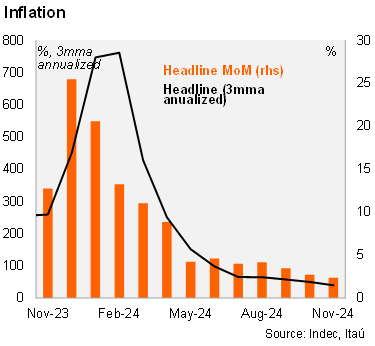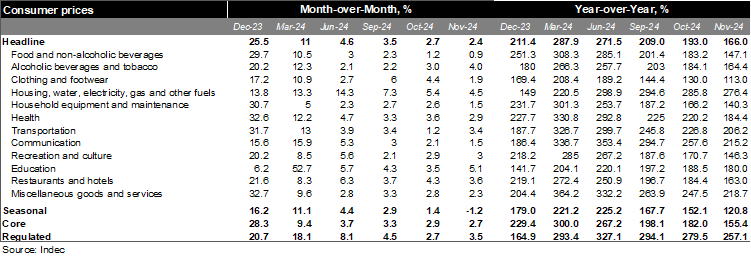According to Argentina’s statistical office (INDEC), consumer prices rose by 2.4% MoM in November, down from 2.7% MoM in the previous month, the lowest monthly rise since July 2020. The print was below market expectations of 2.8% MoM, according to the latest central bank’s survey, and represents the third consecutive monthly downside surprise (totaling 80bps in the period). Annualized quarterly inflation in November fell to 39.9% during the quarter ended in that month, down from 50.1% in the previous month. On an annual basis, inflation declined to 166.0%, from 193.0% in October.

The monthly core measure increased by 2.7% mom in November, marking a deceleration from the previous month (2.9% MoM). Moreover, the year-over-year reading fell to 155.4%, from 182% in October. Prices for regulated products increased by 3.5% MoM and 257.1% YoY, led by higher energy tariffs and fuels. Finally, prices for seasonal products fell by 1.2% MoM due to lower fruits and vegetables prices (mainly tomatoes at -31.8% MoM). The year-over-year reading fell to 120.8% in November, from 152.1% in the previous months.

Our take: We expect the disinflation process to continue in 2025. We now foresee inflation at 30% by YE25, down from 35% in our previous scenario, and significantly below the 120% yoy inflation expected for YE24. The string of lower-than-expected prints also take place as survey-based inflation expectations have continued to edge down. Uncertainty persists regarding the magnitude and timing of the disinflationary effects of the broad set of pro-competition and deregulation measures implemented so far. The INDEC will publish December’s CPI on January 14.
